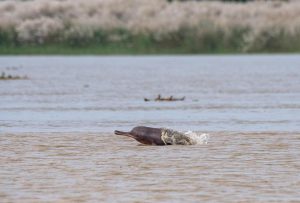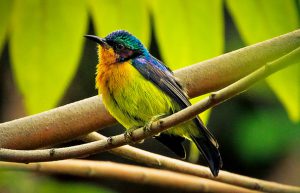The Ganga dolphin was declared India’s national aquatic animal in 2009, and the government approved a National Dolphin Action Plan in 2010 to save the highly endangered freshwater mammal. What has happened since then? “Not very much,” admitted Ravi Singh, chief executive officer of WWF-India, the NGO that wrote the plan and has been trying for decades to save the animal that is revered by millions of Hindus.
After the extinction of the Yangtze dolphin, the Ganga dolphin is one of only three freshwater dolphins left in the world (China also classes the finless porpoise in this category). There are about 1,800 left in the Indian part of the Ganga-Brahmaputra-Meghna basin, down from about 4,500 as recently as 1982. There may be around 600 more left in Bangladesh, and a few in Nepal, all part of the same basin. In Bhutan, the fourth country in the basin, the Ganga dolphin has not been seen for many years.
The two other freshwater dolphins are the Indus and the Amazon. The Indus dolphin, with an estimated population of 1,100, is even more endangered. Only the Amazon species seem to be doing well.
The Ganga dolphin is given the highest level of protection possible under the 1972 Indian Wildlife Protection Act. It is categorised as “endangered” by the International Union for Conservation of Nature.
In Hindu iconography, the Ganga dolphin is the vehicle of Goddess Ganga. Traditionally, it has been seen as an indicator of the health of the river, and there is no record of it being hunted. To the contrary, there are many anecdotes of fishermen returning the dolphin to the water when it became entangled in their nets by accident.
There are similar tales of the Yangtze dolphin being the reincarnation of a wronged maiden, but the species still went extinct in Asia’s longest river. The same fate seems to await the Ganga and Indus dolphins unless urgent steps are taken.
Why are dolphin numbers falling?
There are three main reasons why the Ganga (and the Indus) dolphins are in such danger. The most immediate cause is the use of nylon nets by fishermen. These freshwater dolphins are blind. They swim and find their prey through echolocation – they send out tiny sound waves, and the echoes tell their brain what is around. The nylon in the nets absorbs sound waves instead of reflecting them, explains Sandeep Behera, associate director of the River Basin and Biodiversity Programme in WWF-India; so the dolphin gets entangled in the net.
Dolphins are mammals and must come out of the water every five to seven minutes to breathe. An entangled dolphin cannot, and drowns. Fisheries departments of state governments along the Ganga basin prescribe traditional nets. But there is no ban on the far cheaper and more easily maintained nylon nets, and most fishermen use them.
That is the immediate cause. But there are two more fundamental causes. The first is reduced water flow. Rivers in the Ganga basin are the main suppliers of water to irrigation canals in the north Indian plains, and have been so for over 150 years. Dolphins prefer deep pools, which are shrinking all the time as more and more water is diverted. Plus, there are barrages to divert the water into the canals. The dolphins cannot cross them; and so populations get isolated and more vulnerable.
The second fundamental cause is pollution. Hundreds of factories and thousands of villages throw their untreated waste into the Ganga and its tributaries. At the top of the freshwater food chain, the dolphin accumulates all the harmful chemicals in its body, and often dies. The Yamuna – the largest tributary of the Ganga – turns into a stinking drain downstream of New Delhi, and has no dolphin until the Chambal River empties into the Yamuna over 250 kilometres downstream, giving it a new lease of life.
Ravi Singh says even if the dolphin can adjust to pollution to some extent, its breeding is affected. There is a population downstream of Kanpur – a city in Uttar Pradesh notorious for its polluting factories – but no calves have been sighted among them. Healthier populations exist downstream of Allahabad, once the Yamuna meets the Ganga.
“The rapid decline in the number of dolphins across the country is of great concern and needs immediate attention,” Singh adds. “WWF-India has adopted the Ganga river dolphin as a species of special concern and its work in the Upper Ganga river in the state of Uttar Pradesh has only confirmed that habitat and aquatic biodiversity conservation can succeed when the government, communities and civil society collaborate and work together towards this end.”
Conservation efforts inadequate
There are wildlife sanctuaries in the basin – the Hastinapur sanctuary soon after the Ganga reaches the plains from the Himalayas, the Garh-Narora stretch (a Ramsar wetland site deemed of global significance), the sanctuary on the Chambal upstream of its confluence with the Yamuna and the Vikramshila sanctuary in the middle of the basin in Bihar state.
Forest departments of state governments are in charge of the sanctuaries, but their personnel are neither equipped nor trained to run riverine sanctuaries effectively.
WWF-India has been training them, and in the first week of October 2012 carried out a dolphin population census in the upper one-third of the Ganga basin in the Indian plains (the area in the map). This included programmes to sensitise people along the river banks about the perils being faced by the dolphins.
There is another initiative in the offing by the UK-based beer magnate, Lord Karan Bilimoria, who has a brewery making his Cobra brand of beer near the banks of the Ganga, a little upstream of Patna, the capital of Bihar. With the support of the state government, he is planning to provide protection to dolphins in that stretch of the river, and is asking WWF-India for ideas on how exactly to do this.
But the protected stretches are still too few and far between. Especially for an animal that keeps swimming up and down a river and is quite likely to swim out of a sanctuary, the only hope is to sensitise more and more of the people living along the river, so that they provide protection to the dolphin they have long revered.





